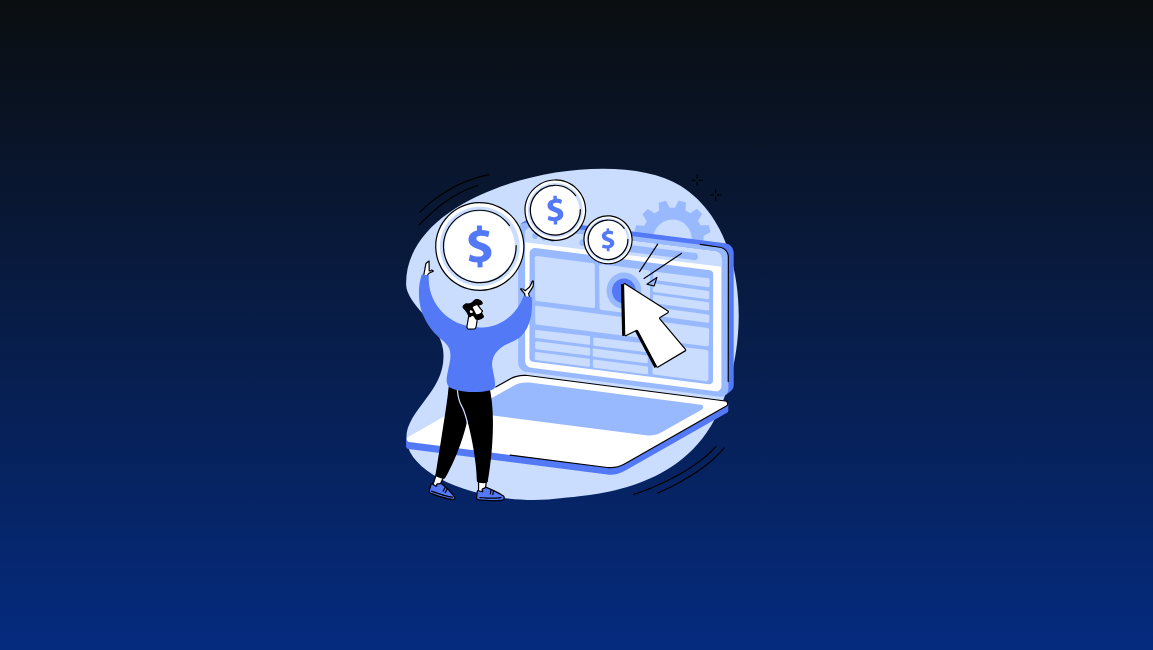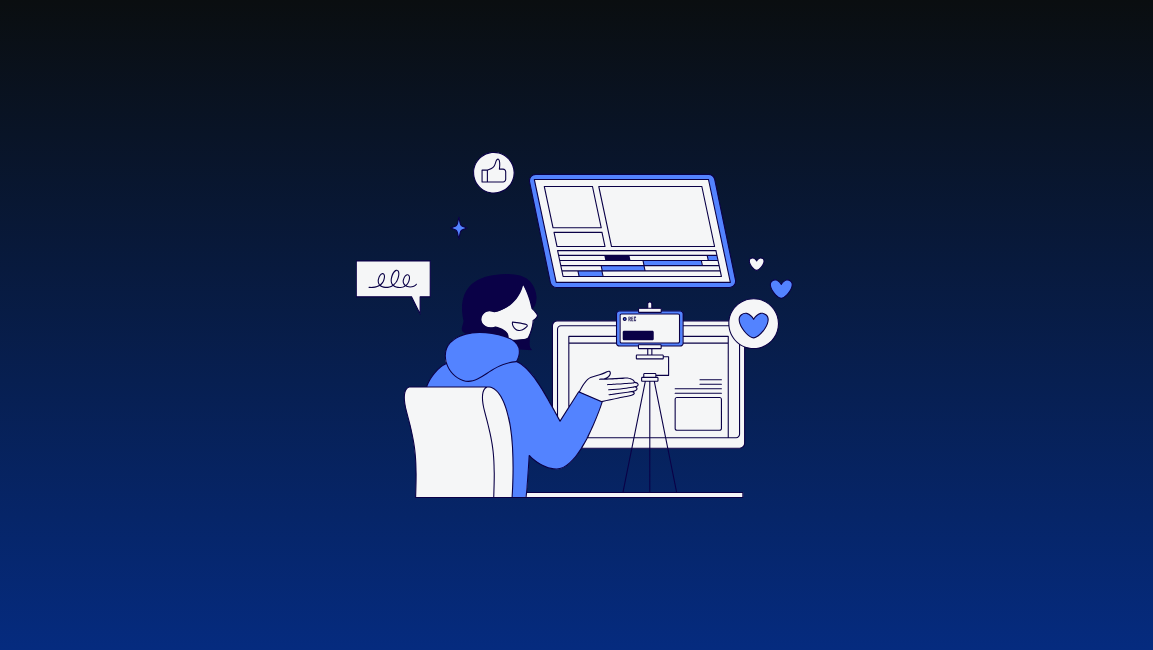Essentially, you have only two ways to increase the sales and revenue of your ecommerce business:
- Get more visitors to the store, assuming more visitors equals more sales
- Get more visitors to buy from the store
The first option requires spending more on marketing and advertising. While it certainly can drive more traffic and revenue to the store, the profit margins drop considerably.
In contrast, getting more sales from your already-incoming visitors is a more profitable solution.
But how do you get more sales from the same number of visitors? It’s all about improving your ecommerce conversion rate.
What Is eCommerce Conversion Rate?
eCommerce conversion rate is the percentage of visitors who complete a specific action on your ecommerce store.
The “specific action” (from visitors/customers) can be anything that directly or indirectly means business growth. For example, visitors joining your email list, adding an item to the shopping cart, sharing positive word-of-mouth on social media, etc., all are growth signs. However, most people refer to “the percentage of visitors/customers that buy from the store” when they say “ecommerce conversion rate.”
Here’s a simple example of ecommerce conversion rate: Let’s assume 1000 people visit a product page, and 20 of them make a purchase. In that case:
Conversion rate = (20/1000) x 100 = 2%
What Is eCommerce Conversion Rate Optimization, Then?
eCommerce conversion rate optimization (CRO) is the process of making incremental changes to your store to increase the conversion rate.
A typical CRO process includes three steps:
- A hypothesis: First, you come up with a logical assumption for a specific change you think will increase conversion rates.
- A/B testing: Then, you put the hypothesis to test to make an objective decision.
- The decision: Based on the test results, you finalize which version of the A/B test you’ll keep.
The A/B test process
An A/B test involves testing two variants of the same page – one with the proposed change and one without. Then, web traffic is sent to both versions to see which one converts better. If the hypothesis proves true, the change is implemented. Otherwise, the original page is maintained.
For example, let’s assume you think changing the size of the “Add To Cart” button might increase the conversion rate. In that case, for A/B testing, you should create a test page with the changed button and send some traffic to it. If a higher percentage of the traffic clicks the button, it means your hypothesis is true, and you should make the change.
The 15 Ways To Improve Your eCommerce Conversion Rate:
1. Create an affiliate program
The impact of a successful affiliate program on conversion rate is often overlooked and barely published about. And since Social Snowball is all about affiliate marketing programs, let’s start this list with this non-obvious tip: create an affiliate program for CRO!
Here’s how a well-executed affiliate program helps increase conversion rate:
It gets you in front of relevant audiences (for free):
Only the people with a relevant audience will join your affiliate program. Why? Because they know they’ll earn the maximum possible commissions only if they promote products fit to their audience (i.e., also your target audience).
For example, let’s say you sell men grooming products. In that case, mainly Instagram influencers who share men’s grooming tips & tricks or affiliate websites in the grooming niche will join you as affiliates because their audience is interested in men’s grooming and hence likely to buy your products (through their link).
Related read: How to proactively find relevant affiliates?
An affiliate program will boost brand credibility and brand trust:
Trust is paramount for conversions. And an affiliate program helps build that trust by borrowing trust from affiliates.
The thing is, your affiliates (influencers, affiliate site owners, customers, etc.) build trust and credibility over time. So, when they tell their audience to buy your products using their affiliate link, they indirectly say: ‘I trust this product, and so should you if you trust me.’
This “borrowed trust,” therefore, contributes a great deal to improving the sales to impressions ratio. Here are some statistics for proof:
- 88% of consumers are inspired to purchase based on what they saw from an influencer,
- 81% of (surveyed) people have purchased by clicking a link shared by an influencer,
- 66% of consumers trust product recommendations as long as an influencer discloses their relationship with the brand.
Pro Tip: Give exclusive discounts to affiliates’ audiences to increase conversions.
2. Create an online community
Creating an online community around your products is a powerful way to build brand loyalty, engage with existing customers, and let your most passionate customers become brand ambassadors.
At Peerboard, we see online communities boost conversion rates in ecommerce stores in several ways:
- Creating your own online community helps drive user-generated reviews, which can increase your conversion rate by fostering a sense of brand loyalty and authenticity.
- Building your own social community can decrease your response time. As a community owner, you will have a central repository for all questions, comments, and feedback and the ability to interact simultaneously with a large number of people.
- The most relevant source for testing when launching new products and services can be your social community. Insights about your new products or services will help increase conversion rates since you will ultimately offer a better product for your customers.
3. Use persuasive, benefit-driven copy
In your product descriptions, don’t focus primarily on the product’s features–customers can see those down in the specifications/technical details/product information section. Instead, focus on how the customer will benefit from owning or using that product.
For example, instead of just saying, “This wireless Bluetooth speaker uses dual precision speakers for superior sound quality,” try something like “Feel the bass thumping through this compact portable Bluetooth cube while streaming your favorite Spotify playlist!” Most people won’t know what a dual precision speaker is anyway. Help them picture all the benefits they’ll get from using your product.
4. Offer limited-time discounts
Offering limited-time discounts and coupons can be an effective way to drive more sales and attract new customers.
One caveat, however, is to be careful about how frequently you rely on discounts to drive sales. If you’re always offering discounts, you’ll train your customers to expect them, and they won’t purchase if there isn’t one.
5. Prominently feature product reviews
People want to know whether they’re purchasing a product that’ll work for them or not, and they want to know what others are thinking of it.
Give them that information right on the product page by prominently featuring customer reviews. This may mean including reviews in the product description, or ideally, help customers quickly see an average star rating and the number of reviews without leaving the product page.
Tip: If you get a negative review, don’t take it down. Instead, use it as an opportunity to respond publicly, make the situation right, and demonstrate that you actually care about your customers.
6. Recover abandoned carts
The average ecommerce cart abandonment rate is 69.82%. That means nearly 7 out of 10 people who add a product to the cart don’t buy it.
If you can successfully implement processes to decrease this number, you’ll skyrocket your overall conversion rate.
One way – and perhaps the most successful way – to recover abandoned cart includes sending a sequence of emails/SMS/etc. to cart abandoners. Statistics show that 45% of cart abandonment emails are opened; 21% of all is clicked on, and 50% of those purchase. In your messages, highlight limited stock, offer a discount, etc., to encourage them to complete the purchase.
7. Make it easy for customers to find what they’re looking for
While this might seem like a no-brainer, don’t underestimate the importance of making it easy for customers to find what they want. The easier it is, the more likely they will buy the product instead of moving on.
In practice, this means you should have:
- A well-organized, logical website structure with categories and sub-categories to help customers get to any page in just a few clicks,
- A search function that allows customers to enter any keyword and receive relevant results,
- Deep filtering feature for excluding unnecessary items from a massive number of search results,
- All the information about the product on the product page,
- Ratings and reviews for each product, etc.
Tip: Show the most important information (for conversion) higher on the page. Dylan Ander of SplitTesting almost 2xed the conversions for a furniture brand by moving the testimonial carousel higher on the page:

8. Streamline the checkout process
The more complicated your checkout process, the lower your conversion rate will be. Streamline the process to make it as quick and easy as possible for customers to complete their purchases.
- Start by only requiring the minimum amount of information you need. For example, if you don’t need a phone number, don’t ask.
- Allow them to use the same billing information as their shipping info.
- Provide a progress bar that indicates where they are in the checkout process.
- Autofill checkout form from information stored in their browser or password manager
- Automatically format as much information as possible, like dates, credit card details, etc.
9. Offer multiple payment methods
42% of US consumers abandon the cart if their favorite payment method isn’t available.
Therefore, it’s crucial to allow customers to pay with all primarily used payment methods – credit or debit card, PayPal, Amazon Pay, Apple Pay, Google Pay, etc. You can even allow them to use an Affirm loan or offer financing for larger purchases.
It’s especially useful to let customers use one-click payment options such as Apple Pay as they speed up the checkout process and increase conversions. Here’s what Shopify found: Checkouts going through Shop Pay (a one-click payment solution) have an average conversion rate of 1.72X higher than regular checkouts.
10. Optimize your site for mobile shopping
More than half of ecommerce customers in the US shop from their mobile devices. So it’s crucial to optimize your ecommerce website for smartphones.
- You need a responsive design that changes the layout and image sizes based on what device they’re using,
- You should also have a mobile search function.
- No zooming or pinching should be needed,
- Buttons should be easily visible,
- And purchases should be just as easy to complete on mobile devices as on desktops.
11. Create a loyalty program
Having a loyalty program that rewards customers for their purchases will encourage them to shop more often, both increasing your conversion rates and customer lifetime value.
A common type of loyalty program rewards customers after a certain number of purchases or after being a customer for a specific length of time. This incentivizes more purchases and more long-term loyalty from customers.
12. Offer bundles, upsells, and cross-sells
As you know from your own shopping patterns, people tend to buy products in multiples. For example, if someone wants a laptop, they might also want a mouse and USB cables. By offering discounts on these bundles and cross-sells, you can increase your average order value and conversion rates (on additional products).
And don’t forget about upsells too. If you offer a superior product for a reasonable price, there’s a good chance many customers will jump on that offer.
13. Retarget
A significant number of people who visit your site don’t make a purchase. However, that doesn’t mean they won’t ever make a purchase – they visited your site for a reason, right?
Retargeting allows you to place relevant ads before those who have come to your site but haven’t purchased. You can customize these ads based on how many times they’ve visited, what pages they viewed, etc.
Through repeated exposure to your brand, you make it much more likely that they’ll eventually buy from you. The rule of seven states precisely this: A prospect needs to “hear” the advertiser’s message at least seven times before they’ll buy that product or service.
14. Create a personalized shopping experience
Personalization is vital as it makes the shopping experience more enjoyable. It also helps increase the conversion rate.
There are numerous ways you can personalize the shopping experience, including:
- Making product recommendations based on past purchases, browsing behavior, or wishlists. For example, if someone viewed a product, they likely want it; therefore, show the product right on their homepage when they visit again to increase the chances of them viewing it again and eventually purchasing.
- Sending personalized email messages and bonuses to customers on special occasions like birthdays and anniversaries
- Offering free shipping if the customer has reached a specific purchase threshold
Personalization demonstrates you know and care about your customers and want to give them a great shopping experience.
15. Use analytics tools to monitor visitor behavior
Evaluating how your customers are interacting with your site is crucial to improving it. If visitors aren’t spending much time on specific pages or aren’t completing their purchases, for example, then you need to know why this is happening and what you need to do to fix it.
There are several analytics tools that can give you insight into how your visitors are behaving. For example, Google Analytics provides a wealth of data, from what pages visitors initially land, the path they take through your site, and what page they exit from. In addition, heat map tools like HotJar can tell you how long visitors are staying on specific parts of your site, as well as where they’re pausing, clicking, etc.
Always Be Optimizing
Optimization is not a one-and-done process. Instead, it involves making one small change at a time, determining whether that change created positive results, and then responding accordingly.
Over time, the minor improvements in your conversion rates can translate into significant increases to your bottom line.
A good conversion rate is one that’s constantly improving, even if it’s only in small amounts. So slowly and consistently begin utilizing the strategies listed above. You may not see big gains immediately but stick with it. The reward is worth the wait.




